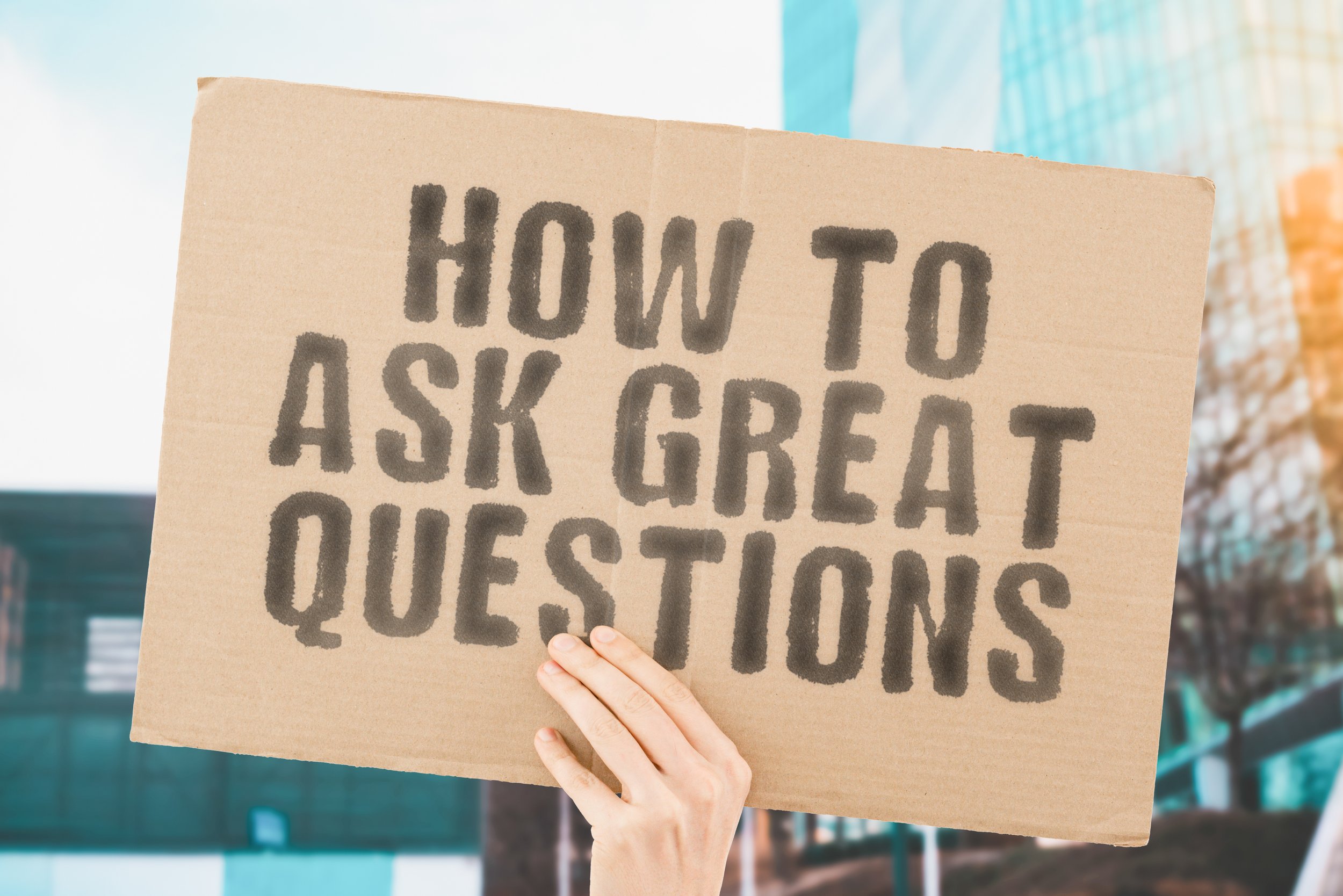The essential leadership skill of asking the right questions
As a people leader, when you’re under the pump and someone comes to you for support or assistance, it is often easier to give them the answer (you think) they need than it is to coach and empower them to discover the answers themselves.
But your role as a leader is to develop your people - to teach them how to fish rather than just handing them a fish - and that only happens when you give them real opportunities to learn.
I’ve posted recently about the power of being present and listening deeply; this time I’m focusing on the third branch of the ‘holy trinity’ of essential coaching skills for leaders: the art of asking the right questions.
So what are the best questions to ask? Well, predictably, the answer is ‘that depends’ - on the situation, and on the outcome you are trying to achieve.
Types of questions
There are many interesting types of questions, and all questions are useful. The skill is using the right question at the right time. Let’s start with the basics and build on.
Open and closed questions
Here’s a wee test.
Read the following questions. Can you identify which ones are open and which are closed?
• Do you know the difference between open and closed questions?
• How do you use open and closed questions in your daily work?
• What feedback have you received on how you use questions?
• Do people feel interrogated when you ask them questions?
Did you guess correctly which ones were which? If not, and this is new to you, don’t worry - read on and all will become clear.
If you know the difference already, great! This will be a useful refresher.
(The answers in order: closed, open, open, closed).
Closed questions
Closed questions are simply questions which can be answered with a ‘yes’ or a ‘no’.
Here are a few examples:
• Are you Scottish?
• Have you ever lived in Sydney?
• Will you be working remotely tomorrow?
• Could you join us for Friday’s meeting?
• Did you see Max at his desk yesterday?
• Would you like to meet for afternoon tea at 3pm?
Closed questions are effective at closing down a conversation. This is great when, for example, you are having a conversation and want to wrap things up (‘Is there anything else you need to get started?’), or nail down next steps (‘John, will you follow up with IT?’)
If, however, you are trying to get to know someone, build rapport, or ‘teach them how to fish’ by finding their own answers, solutions and ideas, closed questions are not your friend - they will not give the other person an opportunity to open up, share their own thoughts, explore options, think creatively or expand on their ideas.
Open questions
Open questions are questions that elicit an open-ended answer, meaning you don’t know what answer you’re going to get.
Here are a few examples:
• How might we achieve that goal?
• Why do you think that happened?
• What are the best options to solve this problem?
• Who might be able to support you with this challenge?
• When are you going to do that?
• Where do you see yourself in 12 months?
• Which option do you prefer?
Open questions help you open up the conversation. They are very useful when you’re having coaching conversations with your team members, particularly at the beginning when you’re trying to get the conversation flowing.
Let’s look at two open questions that deserve a special mention: ‘And what else?’ and ‘Why?’
And what else?
When you’re talking with a team member (or even your whole team) and they’ve come up with a few ideas and you then add in ‘And what else?’, you encourage them to dig even deeper and bring something more to the discussion. In my experience, working in hundreds of coaching sessions, I’ve found that ‘And what else?’ can uncover amazing gems.
The message you are sending when you ask, ‘And what else?’ is that you believe they have more to offer; more ideas, more suggestions, more questions. Try it in your next conversation and see what happens.
Why?
‘Why?’ is a fantastic open question, but it can sometimes have a bit of an edge. Depending on the question, your tone and your emphasis, it has the potential to sound accusatory: ‘Why were you late?’.
In the workplace it might sound like:
Why do you think that’s the best option?
Why did you choose that course of action?
Why do you say that?
‘Why?’ aims to uncover people’s value judgements behind their actions.
It can help you understand how they came to take an action or make a decision; it takes you deeper into understanding the person. Sometimes it can also help uncover a ‘disconnect’ between their personal values and the values of the organisation, which you can then address.
The most important thing to remember is to use it carefully and to use it with curiosity and an enquiring tone.
You might even frame your ‘why’ question like this:
‘I’m keen to understand more about the context in that situation (frame). Why did you choose that particular option to move forward?’ (question).
Engaging your curiosity when you use the ‘Why?’ question can make for really rich conversations. Just keep an eye on your tone.
Top tip: How are you being?
Your mindset, intention, and how you ask your questions are just as important as the questions you ask.
Does the person you’re asking feel like they are being cross-examined in the witness box, or do they feel you are coming from a place of genuine, non-judgemental curiosity? And are you asking questions designed to ‘catch them out’, or are you asking questions to better understand them and/or the situation?
If you are wholly present and genuinely listening (not just waiting for your turn to speak) and your intention is to coach/support/build trust and not to have a ‘gotcha!’ moment, you are on the right track.
Just notice your questions over the next few days. Are they more open or closed? Chances are they’re closed more often than you realise.
If you notice that you are using a lot of closed questions, just pick a new open question to try. You may consider sprinkling ‘How?’ liberally over your conversations and watch what happens.
Now let’s have a look at a question trap that can sometimes get us into trouble.
When is a question not a question? When it’s a queggestion!
You might not have heard of these before, but I’m pretty sure they will be all too familiar.
The term ‘queggestions’ was created by Michael Stratford, a US coach. You may know them as ‘leading questions’.
These sneaky little phrases sound like questions, but they are actually suggestions pretending to be questions.
Here are some examples, along with the underlying message the listener hears:
Do you think you should ask the CEO what she thinks about that before proceeding? (You should ask the CEO what she thinks about that before proceeding.)
Would our customers prefer the other option, do you think? (I think our customers would prefer the other option.)
That sounds like a big risk. Do you think we should proceed with that course of action? (You should NOT proceed with that risky course of action.)
Do you think that’s good enough? (I don’t think that’s good enough.)
Should you ask James for his advice? (You should ask James for his advice!)
…you get the picture I’m sure.
Hot tip: any question that begins with ‘Should you’ is guaranteed to be a queggestion. Avoid it at all costs!
But what if you have some concerns about where your team member is headed with a course of action? Are you supposed to just let them blunder on?
Hell, no! The good news is that there is a much better way of bringing an issue to their attention than using queggestions.
How to reframe a queggestion
Start with an open question - What, How, Which, Who, etc - and remove the specifics of the suggestion you were about to make.
The queggestions above could be reframed as:
What do you think our CEO might say about this?
Which option do you think our customers would prefer?
What might be some of the risks associated with that course of action?
How will you know you’ve been successful?
Who might be able to help clarify that?
Some of you may be thinking; ‘Ah well, that sounds so easy Anna, but what if my team member just can’t see the issues/risks/gaps in the plan..?’
All good, my friend. Then all you need to do is share your opinion … as an opinion, not as a queggestion.
The conversation between a Leader (L) and their Team Member (TM) may look a little like this:
L: Thanks for running me through your plan for this next project.
TM: No problem. I reckon we’re good to go, right?
L: It’s looking pretty good, yes. I just have one or two more questions before we finish up.
TM: Sure! Fire away!
L: What might be some of the other risks associated with this project?
TM: Hmmm. Well, to be honest I don’t really see any other risks, apart from the ones we’ve already covered.
L: OK. From past experience I think there might be a couple more that need to be considered. I’m a bit concerned about the risk around … [and the leader goes on to share the details of their concern].
It’s important to give them the opportunity to answer the question. And you never know, your team member may have come up with additional risks that you hadn’t even thought of.
Then after that, you can add your opinion IF it’s necessary.
Silence can be golden
As you’re learning to use fantastic questions as part of your coaching approach to leadership, sometimes you may fall into the trap of firing questions like a machine gun - you hit them with one, then if they don’t respond instantly, you think maybe they misunderstood so you fire out another question or two, and now they’ve got multiple questions on the table to deal with.
This is not an effective strategy. So, what should you do instead?
…
Can you hear that?
…
Silence.
Asking a great question and then sitting in silence as your team member considers the question sounds really simple, but is in fact quite challenging.
Why?
Because most of us find silence a bit awkward. As soon as silence falls on our conversations, we generally do our utmost to fill it and keep things flowing. But what if you allowed a little more silence in your conversations; what would happen then?
Silence can do the heavy lifting in conversations for you.
A well-placed question followed by silence creates space for your team member to think. Space for them to reflect and consider their answer. Space for their opinion to form. Space to hear what they have to say, as opposed to simply having an echo chamber for our own views and opinions.
Silence also infers that you believe they have something valuable to offer, and you are willing to wait.
Top tip: how much silence is enough?
When you’re practising bringing more silence into your conversations, you can start by simply asking the question and then counting slowly from 1 to 10 in your head.
I guarantee that by the time you have reached 10, your team member will have said something.
Bonus: counting to 10 also gives you something to do, to distract you from adding in your own thoughts too early.
If this sounds like a foreign concept to you (maybe like me you can be a bit of a chatterbox) I’d suggest sharing with your team in advance that this is a new habit that you’re going to be practising.
I’ll tell you a wee story to illustrate.
Why sharing your new leadership practices with your team is important
A few years ago, I was coaching a leader, let’s call him Sam*. Sam had participated in a leadership development program and one of his key objectives following the program was to become a better coach to his team.
He was as keen as mustard, and had bounced out of the development program back into the workplace, guns blazing, ready to become the ‘super coach’ he aspired to be.
As part of Sam’s development program, he had three coaching sessions with me to support him in applying his learnings in the workplace.
On our first coaching call, Sam was taking me through his objectives and shared that he’d had meetings with each of his three team members where he’d used his newly acquired questioning skills, but he sounded a bit perplexed about how things were going.
I remember the conversation as follows:
Me: That’s great to hear that you’ve been applying your questioning skills with your team Sam. Good on you for giving it a red hot go! I notice that you’re sounding a bit perplexed; what’s the challenge here for you?
Sam: Well, it’s a bit weird really. I felt like I was doing such a great job of asking open questions and allowing silence afterwards, but my team was really upset after the sessions.
Me: Oh really? Why was that?
Sam: They all thought they were going to be made redundant!
Me: Oh wow! That’s interesting. Why did they think they were going to be made redundant?
Sam: They told me that I was acting so weirdly, really different to my usual self, that they thought something was up and that maybe they were going to be sacked!
I think Sam’s team were thinking, ‘Okay, so who are you? And what have you done with the real Sam?’
Once Sam had shared with the team that he was trying to implement his learnings and become a better coach they could all see the funny side, but at the time each team member had been very anxious about why their leader was acting so differently and what that might mean for them and their position.
Take a free learning from Sam’s experience: when you’re trying something new with your team - which might be using more silence to allow space for them to think and respond - just give them a heads up about what you’re doing.
This will help in three ways:
• Your team won’t be needlessly concerned.
• You demonstrate your openness to learning and trying new things.
• Your team can support you by giving you feedback on how you’re going.
Questioning with curiosity is such an important skill for you as a leader. Questions are your most powerful tool to enable your team members to develop and grow and resolve their day-to-day issues for themselves.
As you move towards questioning and away from advice-giving you will notice your team members becoming increasingly independent. Set yourself a challenge to ask at least three questions before leaping into advice, and watch the amazing results.
To sum up:
Closed questions, like ‘Can you … ?’ and ‘Do you … ?’, are really useful to wrap up conversations.
Avoid ‘Should you … ?’ at all times!
Open questions, like ‘How?’ and ‘What?’, help you open up a conversation and get it flowing.
Use ‘And what else?’ to encourage your team member to come up with even more ideas and deeper thinking.
Be careful of your tone when you use ‘Why?’
Avoid queggestions – ask a question OR make a suggestion – don’t run them both together.
Let silence do the heavy lifting for you. Try counting to 10 slowly before jumping in.









